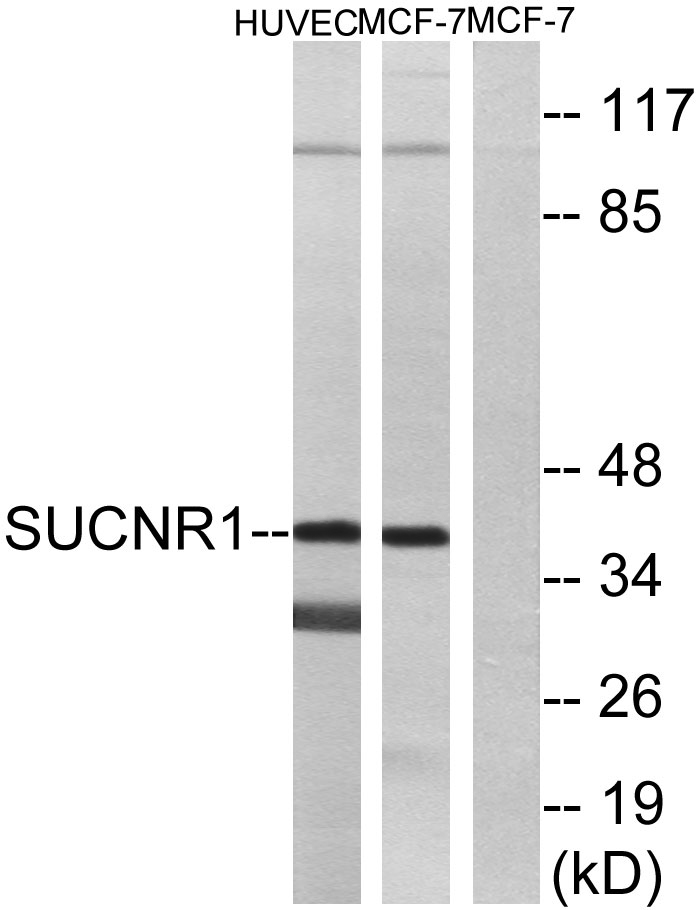- 靶点:
- GPR91
- 简介:
- >>cAMP signaling pathway
- 基因名称:
- SUCNR1
- 蛋白名称:
- Succinate receptor 1
- Human Gene Id:
- 56670
- Human Swiss Prot No:
- Q9BXA5
- Mouse Gene Id:
- 84112
- Mouse Swiss Prot No:
- Q99MT6
- Rat Gene Id:
- 408199
- Rat Swiss Prot No:
- Q6IYF9
- 免疫原:
- The antiserum was produced against synthesized peptide derived from human SUCNR1. AA range:100-149
- 特异性:
- GPR91 Polyclonal Antibody detects endogenous levels of GPR91 protein.
- 组成:
- Liquid in PBS containing 50% glycerol, 0.5% BSA and 0.02% sodium azide.
- 来源:
- Polyclonal, Rabbit,IgG
- 稀释:
- WB 1:500 - 1:2000. IF 1:200 - 1:1000. ELISA: 1:10000. Not yet tested in other applications.
- 纯化工艺:
- The antibody was affinity-purified from rabbit antiserum by affinity-chromatography using epitope-specific immunogen.
- 浓度:
- 1 mg/ml
- 储存:
- -15°C to -25°C/1 year(Do not lower than -25°C)
- 其他名称:
- SUCNR1;GPR91;Succinate receptor 1;G-protein coupled receptor 91;P2Y purinoceptor 1-like
- 实测条带:
- 38kD
- 背景:
- This gene encodes a G-protein-coupled receptor for succinate, an intermediate molecule of the citric acid cycle. It is involved in the promotion of hematopoietic progenitor cell development, and it has a potential role in renovascular hypertension which has known correlations to renal failure, diabetes and atherosclerosis. [provided by RefSeq, Oct 2009],
- 功能:
- function:Receptor for succinate.,similarity:Belongs to the G-protein coupled receptor 1 family.,tissue specificity:Expressed specifically in kidney.,
- 细胞定位:
- Cell membrane ; Multi-pass membrane protein .
- 组织表达:
- Expressed specifically in kidney.
Succinate communicates pro-inflammatory signals to host and regulates bile acid enterohepatic metabolism in a pig model Food & Function Kaifan Yu WB Pig
货号:YT2035
- June 19-2018
- WESTERN IMMUNOBLOTTING PROTOCOL
- June 19-2018
- IMMUNOHISTOCHEMISTRY-PARAFFIN PROTOCOL
- June 19-2018
- IMMUNOFLUORESCENCE PROTOCOL
- September 08-2020
- FLOW-CYTOMEYRT-PROTOCOL
- May 20-2022
- Cell-Based ELISA│解您多样本WB检测之困扰
- July 13-2018
- CELL-BASED-ELISA-PROTOCOL-FOR-ACETYL-PROTEIN
- July 13-2018
- CELL-BASED-ELISA-PROTOCOL-FOR-PHOSPHO-PROTEIN
- July 13-2018
- Antibody-FAQs
- 产品图片

- Western blot analysis of lysates from HUVEC and MCF-7 cells, using SUCNR1 Antibody. The lane on the right is blocked with the synthesized peptide.



